Transcription of American Nurses Association’s Needlestick …
1 American Nurses association sNeedlestick prevention GuideAmerican Nurses association sNeedlestick prevention GuideSupported by an unrestricted educational grant from B-D, Inc. (Becton-Dickinson). 2002 American Nurses association . All rights reserved. TDICT forms reprinted with 1 Chapter One: The Information You 3 One nurse s Story .. 3 Work-Related Bloodborne Pathogen Exposure: The Risks for Health Care Workers .. 4 HIV/AIDS .. 6 Hepatitis C .. 8 Hepatitis B .. 9 Procedure to Follow After a Needlestick or Sharps Injury.
2 10 prevention .. 12 Rights and Protections: OSHA Bloodborne Pathogens Standard .. 14 Chapter Two: Taking 16 Needlestick prevention Committee .. 16 Identify and Document Needlestick and Sharps Hazards .. 18 Using Contract Language .. 22 Filing an OSHA Complaint .. 23 Chapter Three: Device Evaluation, Selection,and 25 Step One: Broad Identification of All Market-Available Devices .. 26 Step Two: Three-Step Selection Process .. 28 Step Three: Institutionalizing Selected Devices .. 30 Step Four: Ongoing Surveillance for Efficacy and for Better Devices.
3 32 Appendix A: 33 Appendix B: OSHA Model Exposure Control 35 Appendix C: EPINet Sharps Reporting 47 Appendix D: TDICT Safety Feature Evaluation 50 Appendix E: TDICT Scenarios and Simulation 54 Table of Contents1 Every year, hundreds of thousands of health care workers are exposed to deadlydiseases like HIV and hepatitis C through Needlestick and sharps today s technology, Nurses no longer need to face such high risks. TheAmerican Nurses association (ANA) is dedicated to working with Nurses across thecountry to significantly reduce Needlestick and sharps injuries.
4 Nurses should nothave to risk their lives every time they use a needle or sharps , as part of its ongoing Safe Needles Save Lives campaign, has created thisguide to help educate you and your colleagues about the risks of Needlestick injuriesand how to prevent them particularly through the evaluation, selection, and imple-mentation of safe needle and sharps devices. Chapter One details the exposure risksfrom injuries especially from HIV, hepatitis C virus (HCV), and hepatitis B virus(HBV) and how these injuries can be prevented.
5 It also outlines what steps youshould take after an injury and your legal rights and protections especially underthe federal 2000 Needlestick Safety and prevention Act. Chapters Two and Threefocus on how you and your colleagues cantake specific steps toward Needlestick pre-vention in your health care steps include creating a needlestickprevention committee, identifying and doc-umenting injuries, evaluating, selecting,and implementing safe devices, filing acomplaint with the Occupational Safetyand Health Administration (OSHA), andusing contract language.
6 In 1999, ANA and the Training for the Development of Innovative ControlTechnologies Project (TDICT) partnered to develop training based on the TDICT process for the evaluation, selection, and implementation of safe devices. ChapterThree outlines that process, developed from dozens of workshops held across thecountry and from material created during 10 years of research by TDICT, using theexpertise of frontline health care workers, especially book is dedicated to the hundreds of health care workers across the countrywho have fought for Needlestick prevention especially to those Nurses who them-selves have been infected with serious diseases from Needlestick and sharps injuriesand to those who died from those diseases.
7 ANA also owes a special thanks to LyndaArnold, who started the inspirational, pioneering National Campaign for Health CareWorker Safety after she became infected with HIV from a Needlestick , we will continue the battle to protect health care workers, so that nursescan take care of patients without risking their own should not have torisk their lives every timethey use a needle orsharps nurse S STORYThe Unthinkable HappensIn 1997, Lisa Black, a 26-year-old nurse and single mom with two young daugh-ters, was excited about her career.
8 She had always wanted to be a nurse . Onenight, she was caring for a patient in the terminal stages of AIDS. She noticedthat his intravenous (IV) tube was backed up with blood and the line was quickly irrigate the line, she filled a syringe with saline and inserted the pre-attached needle into a rubber port on the patient s IV line. While Black wasattempting to aspirate the coagulating blood and then flush the IV line, the patientbecame startled and jerked, causing the needle to dislodge from the rubber port ofthe IV line.
9 The needle punctured the palm of her left hand. She was followed protocol and immediately scrubbed the wound, reported her injury,and went to the emergency department. She was started on a regimen of antiretrovi-ral medications and a protease inhibitor. She put up with the difficult side effects,thinking that if she just could getthrough the side effects and stay onthe post-exposure prophylaxis (PEP)protocol, she would not acquire months later, she began to feelill, and nine months and nine daysafter her injury, she was diagnosedwith HIV.
10 Several months later, shelearned she also was infected withhepatitis C. Today, she is an active member ofher state Nurses association . She has devoted herself to educating others and fight-ing for occupational health and safety protections, so that other health care workerswill not have to suffer her Tragedy That Should Never Have HappenedLisa s injury was 100% preventable. If her hospital had exclusively used needlelessIV systems, she never would have been injured and would not be taking over 20 pillsa day to fight her diseases.











